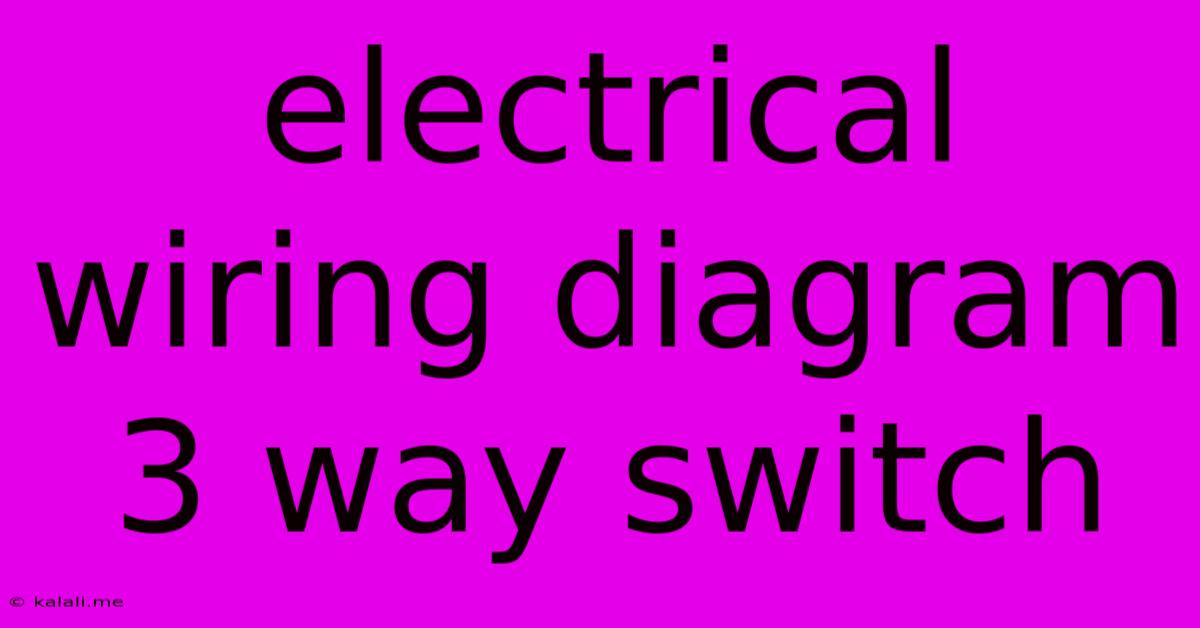Electrical Wiring Diagram 3 Way Switch
Kalali
Jun 09, 2025 · 3 min read

Table of Contents
Understanding 3-Way Switch Wiring Diagrams: Illuminating Your Home's Electrical System
A 3-way switch allows you to control a single light fixture or other electrical device from two different locations. This is incredibly useful in hallways, staircases, or any area where a single light switch isn't conveniently located. Understanding the wiring diagram for a 3-way switch is crucial for safe and effective installation. This article will break down the intricacies of 3-way switch wiring diagrams, ensuring you're well-equipped to tackle this common electrical project.
What Makes a 3-Way Switch Unique?
Unlike a standard single-pole switch, a 3-way switch has three terminals instead of two. This extra terminal is what allows for the control from two separate locations. The key component in this setup isn't just the switches themselves, but also the specific wiring configuration that connects them to the light fixture and power source. Understanding this wiring is essential for a successful installation. This guide will cover both the common and less common wiring scenarios you might encounter.
Deconstructing the 3-Way Switch Wiring Diagram:
The core of any 3-way switch setup involves two 3-way switches and the light fixture. Let's break down the components:
- Power Source: This is where the electricity originates, typically from your home's breaker box.
- Traveler Wires: These are the wires that connect the two 3-way switches. They carry the electrical signal between the switches, allowing you to control the light from either location. There are typically two traveler wires.
- Common Wire: This wire connects the power source to one of the switches. It's crucial for completing the circuit.
- Switched Hot Wire: This wire connects from one of the switches to the light fixture, carrying the power to illuminate the light.
Standard 3-Way Switch Wiring Diagram:
Here's a simplified representation:
Power Source --- Common Wire --- 3-Way Switch 1 (Common Terminal)
|
| Traveler Wires (2) --- 3-Way Switch 2 (Common Terminal) --- Light Fixture
|
|
3-Way Switch 1 (Traveler Terminals)
|
Important Considerations:
- Wire Colors: While wire colors can vary, common conventions use black for hot, white for neutral, and red and black (or other colors) for the traveler wires. Always double-check your wiring before proceeding.
- Neutral Wire: The neutral wire is not directly involved in switching the light but is essential for completing the circuit and ensuring safety. It should be connected correctly to the light fixture and to the neutral bus in your junction box.
- Ground Wire: Don't forget to connect the ground wire to ensure electrical safety.
Troubleshooting Common Problems:
- Light doesn't turn on from either switch: Check all wire connections and ensure the power is switched on at the breaker box.
- Light only turns on from one switch: This is often caused by a faulty switch or an incorrect wire connection. Carefully review your wiring.
Beyond the Basics: Variations and Complexities
While the standard configuration is commonly used, there are variations:
- Multiple Lights Controlled by Two Switches: This involves adding additional switched hot wires to the circuit, one for each light fixture.
- Adding a Dimmer Switch: Integrating a dimmer switch into a 3-way setup requires specific dimmer switches designed for 3-way applications.
Conclusion:
Mastering 3-way switch wiring diagrams empowers you to enhance your home's functionality and convenience. By understanding the components, connections, and troubleshooting techniques, you can confidently tackle this electrical project. Remember, safety is paramount. If you are unsure about any aspect of this process, consult a qualified electrician. They can ensure the job is done correctly and safely, preventing potential hazards.
Latest Posts
Latest Posts
-
Wine Fridge Temperature For Red Wine
Jun 09, 2025
-
Can You Paint Over Oil Paint With Latex
Jun 09, 2025
-
How To Cancel Dev Mode Arc
Jun 09, 2025
-
How To Pick A Puppy From A Litter
Jun 09, 2025
-
Outdoor Faucet Pressure Relief Valve Leaking
Jun 09, 2025
Related Post
Thank you for visiting our website which covers about Electrical Wiring Diagram 3 Way Switch . We hope the information provided has been useful to you. Feel free to contact us if you have any questions or need further assistance. See you next time and don't miss to bookmark.